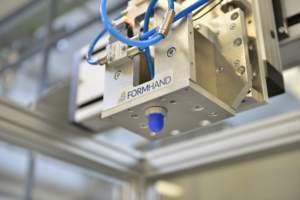 Yesterday, we learned that 3D printed silicone leader ACEO, a brand launched by German chemical company Wacker Chemie AG in 2016, made its first public disclosure of fluorosilicone 3D printing, which is a 100% elastomer that combines the good resistance of fluorocarbons with the temperature properties of silicones. Visitors to the 3D Print expo in Lyon, France, can see some sample fluorosilicone 3D printed parts at Wacker Chemie’s booth #E13 next month.
Yesterday, we learned that 3D printed silicone leader ACEO, a brand launched by German chemical company Wacker Chemie AG in 2016, made its first public disclosure of fluorosilicone 3D printing, which is a 100% elastomer that combines the good resistance of fluorocarbons with the temperature properties of silicones. Visitors to the 3D Print expo in Lyon, France, can see some sample fluorosilicone 3D printed parts at Wacker Chemie’s booth #E13 next month.
 But this isn’t the only event where the company is showing off new developments. June 5-7, Wacker Chemie and its ACEO brand, which also introduced multi-material 3D printing for silicones last year, will be presenting its latest innovation – silicone 3D printing for soft robotic grippers – at the Rapid.Tech + FabCon 3.D. international trade show at Messe Erfurt in Germany.
But this isn’t the only event where the company is showing off new developments. June 5-7, Wacker Chemie and its ACEO brand, which also introduced multi-material 3D printing for silicones last year, will be presenting its latest innovation – silicone 3D printing for soft robotic grippers – at the Rapid.Tech + FabCon 3.D. international trade show at Messe Erfurt in Germany.
Soft robotics is a subfield of robotics that uses flexible, compliant materials to build robots which can mimic living organisms and adapt to what’s around them. Because soft robotics offer more flexibility and adaptability in completing tasks, such as making robots safer to work with around humans, there are many applications for the field, especially when it’s combined with 3D printing, like creating better prosthetics.
3D printing is also often used to fabricate grippers that have complete freedom of function and design – even ones that can sense and respond to their own surroundings. By introducing its silicone elastomer for this application, ACEO can easily and precisely customize soft robotic grippers in different shapes and sizes using a unique drop-on-demand 3D printing technology. The company can now fabricate pneumatic silicone actuators with extraordinary architectures and motions, which are programmable and bio-inspired.
According to Dr. Bernd Pachaly, the head of the ACEO brand, the company uses a liquid silicone rubber formulation, made up of silicone polymer, crosslinker, reinforcing filler, and a catalyst to crosslink the high viscous mixture, in order to form rubber. Silicone elastomers are inorganic synthetic rubbers which combine various chemical and mechanical properties, like color variation and hardness, that are maintained during 3D printing; this is not possible with organic elastomers.
 High-tech silicone, which has been produced industrially for 70 years, is known for its elasticity and long lifespan. It’s also media-resistant and very temperature-stable, making it a good material for a number of applications. This versatile material can be formulated to either be insulating, or electrically conductive, and has, according to ACEO, a “nearly limitless color portfolio,” which includes black and highly transparent grades.
High-tech silicone, which has been produced industrially for 70 years, is known for its elasticity and long lifespan. It’s also media-resistant and very temperature-stable, making it a good material for a number of applications. This versatile material can be formulated to either be insulating, or electrically conductive, and has, according to ACEO, a “nearly limitless color portfolio,” which includes black and highly transparent grades.
ACEO’s elastomer, made from 100% silicone and based on its parent company’s advanced rubber silicone technology, is biocompatible and food compliant, as well as flexible and resistant to radiation. Silicone objects fabricated with 3D printing are comparable with more conventional methods of manufacturing, including rapid prototyping and injection molding.
This new technology by ACEO is based on drop-on-demand technology, which allows for both design freedom and precision. The print head deposits single voxels of silicone on the platform to form layers, each of which is then cured with UV light to build the final 3D printed silicone object. Eco-safe support materials are also added, which can be easily washed off with water once the print is removed. Then, to get their final mechanical properties, the parts are post-cured.
“We are proud to present a new 20 Shore A silicone, now we can offer 20 to 60 Shore A, a compelling range not only for soft robotics,” said Dr. Pachaly. “We will keep the speed of our development to further broaden our service offerings.”
ACEO customers can upload CAD designs in a web shop, which will then be 3D printed in silicone in the Burghausen Print Fab in Germany and shipped worldwide. Several additional services to accompany this, such as contract development for material and design, are also available through an interdisciplinary team. In addition, several R&D collaborations with research institutes and universities will hopefully, as ACEO puts it, increase “the expertise in this highly specialized field of 3D printing.”
To see its new applications for yourself, visit ACEO at booth #2-700 at Rapid.Tech next month.
Discuss this and other 3D printing topics at 3DPrintBoard.com or share your thoughts in the Facebook comments below.
[Images provided by ACEO]Subscribe to Our Email Newsletter
Stay up-to-date on all the latest news from the 3D printing industry and receive information and offers from third party vendors.
You May Also Like
3D Printing News Briefs, April 13, 2024: Robotics, Orthotics, & Hypersonics
In 3D Printing News Briefs today, we’re focusing first on robotics, as Carnegie Mellon University’s new Robotics Innovation Center will house several community outreach programs, and Ugogo3D is now working...
Rail Giant Alstom Saves $15M with 3D Printing Automation Software 3D Spark
3D Spark has entered into a three-year deal with the rail giant Alstom. Alstom, a transport behemoth with annual revenues of $16 billion, specializes in the manufacture of trains, trams,...
Meltio Expands Global Reach with New Partnerships in the Americas and Europe
Spanish 3D printing manufacturer Meltio has expanded its sales network across the globe. With the addition of three new partners in the United States, Brazil, Argentina, and Italy, Meltio aims...
3D Printing Webinar and Event Roundup: April 7, 2024
Webinars and events in the 3D printing industry are picking back up this week! Sea-Air-Space is coming to Maryland, and SAE International is sponsoring a 3D Systems webinar about 3D...


































